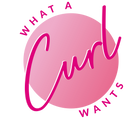What is CGM?
So what exactly is CGM??
On this page you will find a thorough glossary of terms used throughout our site in terms of talking about curly hair products. If you are new to CGM and finding it confusing to know what products to buy, its ok we are here for you!
CGM stands for Curly Girl Method. Its a particular way of looking after naturally curly, wavy, coily hair. The main purpose of the method is to remove silicones, parabens, alcohols, SLS's and sulphates from your hair routine. Curly hair is not the same as straight hair and should be treated as such.
Due to some changes in the CGM and what ingredients are accepted and what are not we have decided to tailor our products to all people; some who follow the method and some who dont.
CGM is strictly no lather shampoos, no oils and butters. However we do stock products that contain those ingredients and we do stock shampoos/low. On our site you will find we have marked specially what is CGM approved and what is not. We hope this helps with any confusion, and our end game is to help anyone who wants to care for their natural hair. We welcome you to ask any questions you have.
So why not Sulphates (SLS)?
Some sulfates that are found in regular hair care products are so strong they are found in industrial cleaning products and engine cleaners. When used to clean human hair, these harsh cleaning agents cause two major issues; firstly the harsh ingredients disrupt the natural state of the hair cuticle causing it to be rough which in turn causes frizz and dryness; Secondly the use of harsh ingredients in hair care products like shampoo can strip away the natural oils produced by the body to moisturise the scalp and hair. Curly hair needs moisture!
Why no silicones?
Silicones can be bad for curly hair because it can cause the hair to have a coating on it which is an illusion for people because initially it makes the hair feel smooth and soft but over time it builds up on the hair. The coating then stops any water or other moisturisers (Like conditioner) from getting into the cuticle which then causes the hair to feel dry and frizzy. It doesn't work long term, so stay away from silicones.
Why no parabens?
Parabens are a preservative that is often used in skin care/haircare products. It has been linked to altering hormones and until its proven otherwise its really best to avoid them.
Why no alcohols?
I think this one is obvious but any alcohols for curly hair are terrible as they dry the hair out and are definetly best avoided. They are mainly in hairsprays and "dry shampoos" so always check when buying those products.
The other thing to avoid with curly hair is over using heat styling tools, like blowdrying, hair straighteners or curling tongs. The only heat you should be applying is a diffuser on the end of your hair dryer for occasional use. Air drying works just as well so don't stress too much if you don't have one!
CGM was created by Lorraine Massey and is well famous for her techniques and opinions on not using shampoo. Some people over time have adapted the method to suit themselves. Theres really no wrong way if you are getting results you are happy with. However we want to be clear that the CGM is a specific way and does not allow for particular products in the method.
GLOSSARY
No-poo; a no lathering shampoo/cleanser which wont strip any natural oils from the hair
low poo; similar as above but may have a small amount of foam/lather
plopping; is the act of using a t-shirt, tea towel, cotton wrap (muslin) to draw moisture out of the hair to prepare for styling. This encourages the curl to form. You can wrap your hair for 5-10minutes, or do a "micro-plop" by squeezing the hair upwards with a natural fibre material
Cast; to acheive a product cast on the hair usually with gel that locks in moisture. You will feel the cast once hair is fully dry.
SOTC; "scrunch out the crunch" this is the act of scrunching the hair once fully dry with a gel "cast" to get rid of the crunchy feeling from the hair to release soft curls
roping; by massaging conditioner or styling product into the hair to achieve maximum moisture. pretend you are climbing a rope. This action is done on the hair by using your thumbs up and down the hair.


